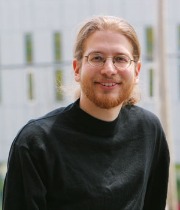
From prodigy to professor: Erik Demaine
 Erik Demaine (BSc’95) was an outstanding student from the start, enrolling in Dalhousie at age 12 and completing his BSc in Computer Science when he was 14. He has now been honoured as an Outstanding Student by Science Atlantic, which is celebrating its 50th anniversary.
Erik Demaine (BSc’95) was an outstanding student from the start, enrolling in Dalhousie at age 12 and completing his BSc in Computer Science when he was 14. He has now been honoured as an Outstanding Student by Science Atlantic, which is celebrating its 50th anniversary.
Dr. Demaine doesn’t remember ever feeling like an unusual student. “I fondly recall hanging out with my fellow students in the computer science lounge, watching and adlibbing episodes of Star Trek on a TV with the volume muted,” he says.
In his third (and final) year at Dalhousie, Dr. Demaine attended the 1994 Science Atlantic Computer Science Conference and partook in the Joint Math Conference as well.
Science Atlantic (formerly the Atlantic Provinces Council on the Sciences – or APICS)
APICS) has maintained a mission to “advance post-secondary science education and research in Atlantic Canada,” offering opportunities to students and support to educators through its annual conferences. The conferences include lectures, symposiums and competitions such as the Computer Science Programming Competition, in which Dr. Demaine participated.
“I played a lot of video games as a kid, and one day asked my dad about how people made them,” says Dr. Demaine. “Then we started exploring computer programming together, which led me to computer science.”
From prodigy to professor
Dr. Demaine’s latest computer science research caused him to return to the game controller as he co-authored a paper titled “Classic Nintendo Games are (NP-)Hard,” which proves that even a computer cannot earn a perfect score in Super Mario.
After completing two graduate degrees at the University of Waterloo in 2001, Dr. Demaine became the youngest professor to ever teach at the Massachusetts Institute of Technology (MIT). As an author of four books, collaborator on close to 300 articles and other publications, and the co-director of a short film, he has not slowed down yet.
He credits the beginnings of his extensive research career to his undergraduate advisor Dr. Srinivas Sampalli, who encouraged him to write papers and give talks while at Dalhousie. Now, Dr. Demaine enjoys inspiring a new generation of young researchers. “I like the challenge of finding the simplest possible way to explain a difficult solution, often leading me to think about simplifying the solution itself,” he says. “I also like the performance aspect of teaching—making material entertaining, funny and generally enjoyable.”
Artistic formulae
Although currently instructing courses in the Department of Electrical Engineering and Computer Science, Dr. Demaine has an impressive artistic résumé as well. Using his research background in folding algorithms, he has produced sculptures that have been displayed at galleries including the Museum of Modern Art and the Smithsonian American Art Museum.
“My dad’s background is in visual arts, and he saw the same kind of artistic creativity in the mathematics I was doing,” he says. “So he started doing mathematics with me, and then we started designing and building sculptures together using that mathematics. So the two fields evolved pretty closely for me.”
This summer, Dr. Demaine will be teaching alongside his dad at the Pilchuck Glass School, offering a class on glass folding. “The class is experimental, as we’re still figuring out all the many ways to incorporate folding (and all our experience with folding paper) into hand-blown glass,” says Dr. Demaine.
Programming the future
Dr. Art Sedgwick, who recently passed away, had been one of his first professors and taught him programming languages and algebra. Dr. Sedgwick often said that, “Erik is a good example of the benefit of combining computer science and math.”
Dr. Sedgwick received recognition from Science Atlantic as an Outstanding Contributor. Science Atlantic also named their keynote lecture after the former chair of the Computer Science Committee. When he first became involved in Science Atlantic, computer science was still part of the math department. The Math Committee had an annual competition and computer science followed suit, with Dr. Sedgwick helping to create problems for the programming competition.
Dr. Sedgwick had been very involved with the Computer Science Programming Competition and noted that, “many faculty in computer science have limited opportunity to do programming and enjoy being involved in the Computer Science Programming Competition,” adding that “the winners of the annual competitions are highly sought after by large multi-national companies like Google, IBM and Microsoft.”
He believed that Science Atlantic provides students with the unique opportunity to collaborate with faculty on projects and present their research to an audience of peers, and that it gives students exposure to a wider world and our grad programs a place to recruit good students.